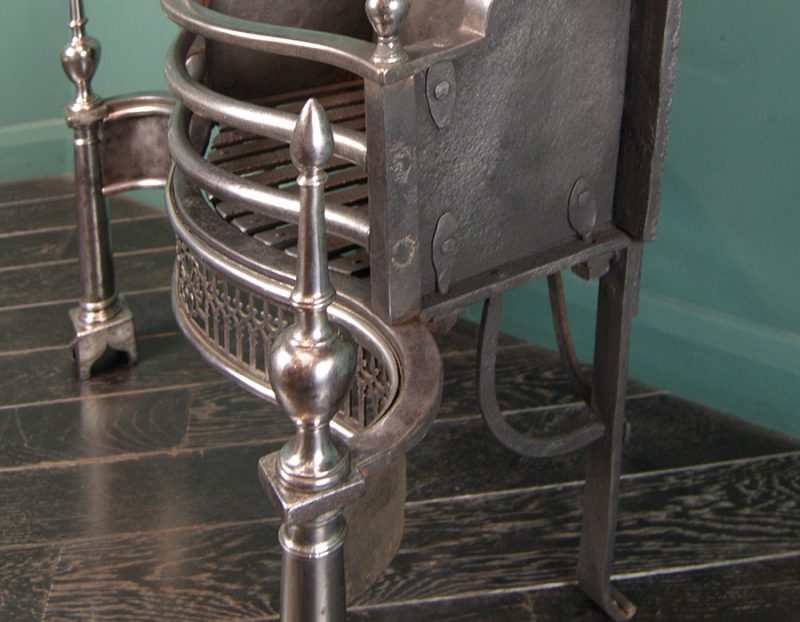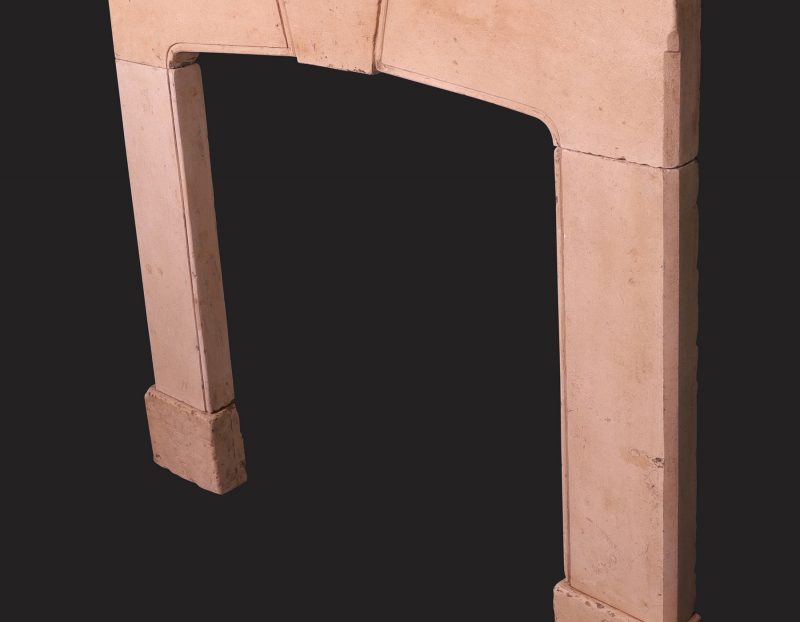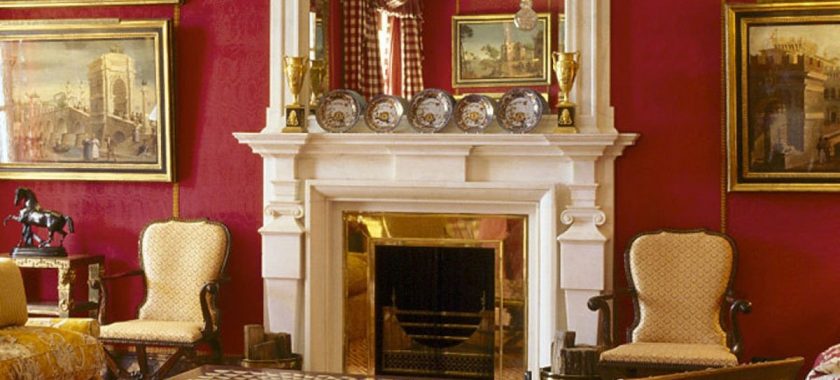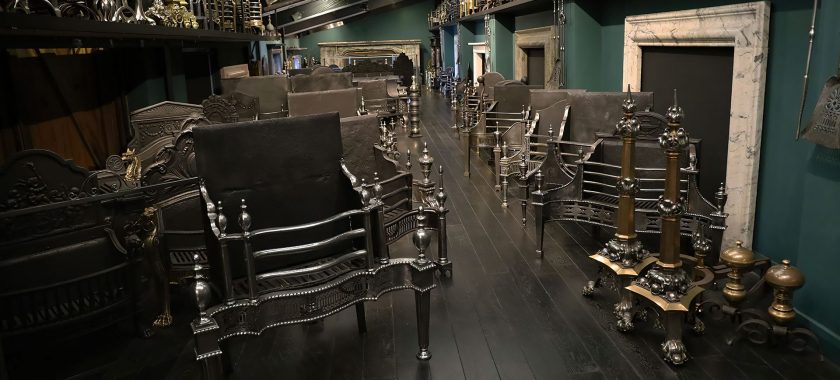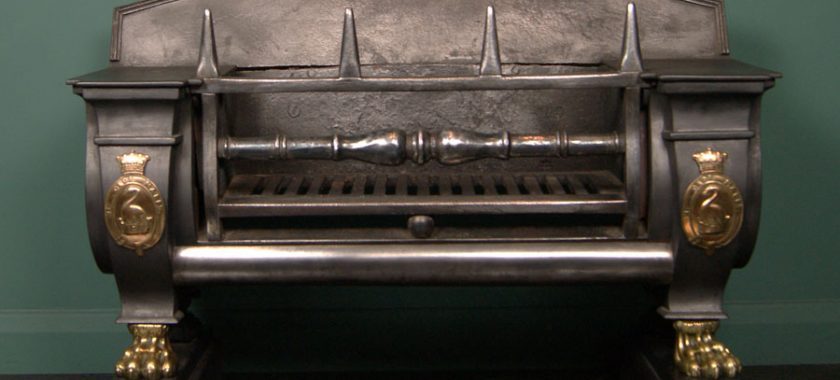This article explains why 18th and 19th century fire grates are sought-after today and discusses three key artistic styles from the period, namely Neo-Classical, Neo-Gothic, and Arts & Crafts, with pieces from our collection shown by way of example.
Antique fire grates and fireplaces are often highly-regarded by collectors due to the high-quality materials and workmanship employed in their manufacture. They were created with such care and attention to detail because of the vital role that the fireplace played in the lives of 18th and 19th-century people. The fireplace was the focus of any room, being a vital source of heat during the cold winter months. Before the advent of electricity, adequately lighting a large room was no trivial task, so the fireplace was also an important source of light – sometimes aided by the use of reflective brass panels.
As well as heat and light, the fireplace provided ventilation, drawing old, stale air up the chimney to be replaced by fresh air from outside. In an era where homes were often poorly ventilated, this made an enormous difference to the air quality of a room.
Additionally to all of these practical benefits, the fireplace also greatly enhanced the aesthetics of a room with the gentle sound and mesmerising effect of the flames. It is no wonder that many scenes from the literature of the period depict characters staring into the fire for inspiration and solace.
Since fireplaces were of such vital importance, their design and craftsmanship were given the utmost consideration with incredible creativity, skill, and attention to detail going into their manufacture. They were considered works of art, to be enjoyed along with the warmth, light, clean air and pleasant atmosphere that an open fire would bring to the room. Back in the less distracting times before television, people would spend a great deal of time gazing at their fireplaces. In fact, humans have huddled together around fires for hundreds of thousands of years. The designers of fireplaces in the 18th and 19th centuries were well aware of this, and they recognised the fire place’s significance as a social catalyst that brought people together to share its warmth and admire its beauty.
“We remember though all the firelit glow
Of a great hearth’s gleam and glare,
And we looked for a space at each happy face
And the love that was written there.”
― Caris Brooke
Neo-classical Fire Grates
Spanning from the 1760s to the 1840s was the neoclassical period of art, which influenced many of the finest fire grates. Designers were able to capture the awe-inspiring nature of ancient Roman, Greek, and Egyptian architecture. Often, Neo-Classical fire grates would feature pillars reminiscent of ancient temples, often including intricate patterns and figurative motifs, such as classical figures and mythological creatures. Much sought after today, are so-called, sarcophagus grates from the period are reminiscent of the coffins of Egyptian pharaohs and strike a most formidable form – supported by the paws of mythological creatures and adorned with esoteric symbols that bring to mind the majesty of that once-great civilisation.
The fusion of classical architecture with 18th Century fire grate and fireplace design brought about something entirely unique as pointed out by William Chambers in his Treatise on Civil Architecture published in 1759.
“As the Egyptians, the Greeks, and the Romans, to whom architecture is so much indebted in other respects, lived in warm climates where fires in the apartments were seldom or never necessary, they have thrown but few lights on this branch of architecture.”
It was quite the feat of imagination to render a technology unknown to these ancient people according to the stylistic methods they employed. This is one of the reasons such pieces are so sought-after today.
Gothic Revival Fire Grates
Beginning in the second half of the 18th Century and spanning all through the 19th was the Gothic Revival period (also known as the Neo-Gothic period). Inspired by the incredible architectural feats of the medieval period, as well as a desire to return to past values and traditions. The Gothic Revival movement permeated much art and architecture of the period, complementing – and sometimes superseding – Neo-Classical work.Neo-Gothic fire grates captured the detail and splendour of medieval architecture, often featuring highly intricate patterns and mythical creatures reminiscent of the gargoyles and Griffins adorning Gothic cathedrals. These features give Neo-Gothic fire grates a rather striking nature, eliciting a sense of mystery, romance, and spiritual transcendence.
“The Gothic Revival was not so much a return to the Middle Ages as a forward-looking attempt to capture the spirit of an earlier time and to adapt it to the needs of the present.” – James Fergusson, “A History of Architecture” (1861)
While the Neo-Classical art prizes reason and order, Neo-Gothic pieces aimed to convey a sense of emotion and spirituality so it was more organic, asymmetrical, and extravagant. You can clearly see this marked difference by comparing the works from the respective eras in our collection.
Arts and Crafts Fire Grates
The late 19th century saw the advent of the Arts and Crafts movement. It was in part a rejection of the mass production that the industrial revolution had made possible, which Arts & Crafts pioneers like William Morris pointed out had sacrificed pride & creativity at the altar of productivity. The call to return to a more natural approach to art is evident in Arts and Crafts fire grates through the organic style of their design featuring flowing, curving lines – often including flowers and leaves. All of these features lend Arts and Crafts fire grates a sense of lightness and movement found in the natural world.
“The Arts and Crafts movement was a response to the dehumanizing effects of industrialization, and a celebration of the beauty and simplicity of handmade objects.” – John Ruskin (1819-1900)
With the incredible thought and detail that went into their design and production, it is no surprise that the finest fire grates and fireplaces of the period are prized by collectors today, as well as homeowners who wish to recreate a delightful aspect of a bygone era. Nothing can compare to the nostalgically romantic atmosphere created by the crackling of logs, flickering flames, and warmth of a traditional fireplace.
“Peace, a fireplace, books, silence … Before this was seen as one philistinism. Now these are dreams of a lost paradise.”
― Erich Maria Remarque, Arch of Triumph
At Gibilaro Design, we are proud to say we have the most comprehensive collection of antique fire grates in the UK – including work from the most sought-after designers of the 18th and 19th centuries. Our fire grates are meticulously restored in our in-house workshop using a process that has taken us 25 years to perfect. You are welcome to browse our collection or contact us for more details.


